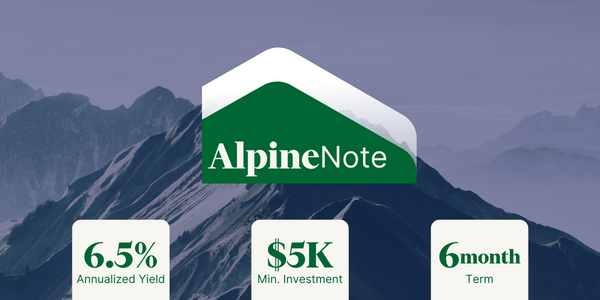At EquityMultiple, we believe alternative investments offer the benefits of diversification that investors need to effectively balance their portfolios in times of economic uncertainty. In particular, when inflation is high, investors can stand to benefit from asset classes that have low correlation to public stock and bond markets. To put this another way, we believe incorporating a variety of investments in your portfolio can help mitigate at least some volatility risk and potentially increase its performance over time.
As a self-directed investor, however, it can be difficult to decide which investments are the right fit for your portfolio. That’s why we created EquityMultiple’s Guide to Alternative Investments.
About the Guide to Alternative Investments
EquityMultiple’s Guide to Alternative Investments is organized across a volatility spectrum, with less volatile investments at the top, and more volatile investments at the bottom.* Among other considerations, we’ve also included the level of liquidity, and whether we think the investment serves as an inflation hedge and/or portfolio diversifier. Note: this is intended to be a fluid matrix based on EquityMultiple’s current views. We will seek to update the matrix as the market shifts and individual product offerings evolve.
For the purpose of this article, we’ll highlight select investments from across the spectrum, including several types of alternative investments, as well as more traditional investments for comparison:
Certificates of Deposit (CDs)
Certificates of Deposit sit at the top of the spectrum in the savings category. Per the SEC, CDs are generally considered to be one of the safest options because you invest a fixed amount of money for a fixed amount of time, often at a fixed interest rate.1 Your money is also insured up to $250,000, adding an additional layer of protection.1
Note: the current yield for CDs is 1.26 – 2.75%. If you already own CDs, you may want to consider adding diversification across medium liquidity savings alternatives that can provide potentially higher yields.
Alpine Note
For a short-term, high-yield savings alternative, we would consider the Alpine Note. Functionally comparable to a corporate bond, capital funded into the Alpine Note is used to pre-fund EquityMultiple’s future real estate offerings. Accredited investors who participate in the Note receive monthly distributions and can potentially capture an attractive rate of return in a short period of time (i.e. six to nine months). Read more on EquityMultiple’s short term notes here.

60% Alternative/Public 24/16 Portfolio
Realistically, we recognize that most investors will not dedicate 60% of their portfolios to alternative assets. That said, this sample portfolio can still serve as a helpful data point for investors who may be considering allocating a higher percentage of their portfolio to alternatives. Please note that your allocation should be a function of your personal tolerance for risk, and suitability of the investment products given your portfolio and timing/liquidity constraints, amongst others.
We’ll dive into more detail on the traditional 60/40 portfolio later, but for now, just note this more aggressive approach has both higher historical annualized returns, and lower historical volatility in the same 10-year timeframe.
Mezzanine Debt
Mezzanine debt is a form of bridge financing, which holds payment priority over all equity. Given its position in the capital stack, mezzanine debt typically offers less upside potential than equity, although investors are also protected if the borrower should default. As such, we believe it offers the potential for strong risk-adjusted returns.
See below for a sample of past EquityMultiple mezzanine debt offerings.1
1The above investments are not representative of all investments of a given type or of investments generally. Past performance is not necessarily indicative of future results. There can be no assurance that an EquityMultiple investment will achieve its objectives or avoid substantial losses.
Public 60/40 Portfolio
A traditional 60/40 portfolio consists of 60% stocks, and 40% bonds. Investing in these two assets, which sit on opposite ends of the risk spectrum, we believe, at least in theory, helps investors maintain a balanced, diversified portfolio.
However, we would argue that portfolio diversification is actually somewhat limited. Investors may spread their risk across multiple stocks and bonds, but they will likely not see the same benefits as someone who includes assets that aren’t strongly correlated with one another.
It’s worth reiterating: non-correlated assets can benefit the entire portfolio by reducing overall risk and sensitivity to geo-political events. In an inflationary environment, for instance, the performance of both stocks and bonds may suffer as the Fed raises interest rates to combat inflation, undercutting the traditional 60/40 diversification argument. To offset this scenario, accredited investors may want to consider investing at least some capital in private real estate, which can serve as a hedge against inflation.
Preferred Equity
Preferred equity is subordinate to debt, but senior to all common equity investments. Like mezzanine debt, preferred equity provides real estate sponsors with gap funding. However, preferred equity investors are typically entitled to additional profits if the project does well.
At EquityMultiple, the forecasted returns for this investment structure must fall within our target ranges of 6-12% current net preferred return, and 10-18% total net preferred return as of July 2022. See below for a sample of past EquityMultiple preferred equity offerings.1
1The above investments are not representative of all investments of a given type or of investments generally. Past performance is not necessarily indicative of future results. There can be no assurance that an EquityMultiple investment will achieve its objectives or avoid substantial losses.
Real Estate Investment Trusts (REITs)
One of the main benefits of publicly traded REITs is that they are accessible, since shares can be purchased or sold on major stock exchanges. This means they are highly liquid, as you can see in the matrix above.
Although REITs provide some exposure to real estate, the value of REITs can still fluctuate as investor sentiment changes. In fact, REITs tend to be correlated with the stock market. For more insight into why we think it may be beneficial to invest in private real estate, rather than just public REITs, please read this article. We found that EquityMultiple’s multifamily offerings actually outperformed three of the top public multifamily REITs upon our analysis in October 2021.3
Individual Stocks:
At the end of the spectrum, we believe individual stocks, when invested in on a one-off basis, are the riskiest of all the investment types found in the matrix above. After all, investors must do their own research and hand-pick which publicly-traded companies they believe will perform well. This is not an easy task, as valuations can quickly shift, resulting in either significant loss or gains.
Individual stock investments also tend to be subordinate to other investments in the capital stack, (including senior debt, mezzanine debt, and preferred equity). Moreover, their publicly traded nature may lead to pricing that does not reflect underlying (true) value. Or, given fees associated with public bankruptcies and payouts to senior positions in the capital stack, they may lack the underlying collateral to recoup (a part of) the investment.
The Bottom Line
We hope our Guide to Alternative Investments serves as a helpful reference point for investors looking to adjust their portfolio allocations. Take a look at the range of options, do your due diligence, and decide which investment strategies best match your current goals. Remember, while you may make some tradeoffs between various levels of risk and return, we advise that your portfolio not remain static. Investors can (and should) reallocate funds to different investment opportunities as economic conditions and their own needs change over time.
We believe including more resilient investment categories and building a truly diversified portfolio – in which underlying investments have a different response to factors such as the interest or inflation rate, and (elongated) geo-political events – further reduces the strain associated with constant monitoring and costs of reactionary adjustments to an investment portfolio.
Investors may also want to consider the liquidity risk associated with certain investments. For instance, EquityMultiple offers a variety of capital types and target hold periods, which we believe can help mitigate this risk to some extent. In the case of longer maturities, investors may even capture an illiquidity premium.
If you have any questions, please feel free to reach out to our Investor Relations Team at ir@equitymultiple.com, or schedule time to discuss your portfolio here.
1 Source: Investor.gov, June 2022
2 Source: A Wealth of Common Sense, June 5, 2022
3 Source: EquityMultiple: Multifamily REIT Dividends vs EquityMultiple Investments, October 2022












